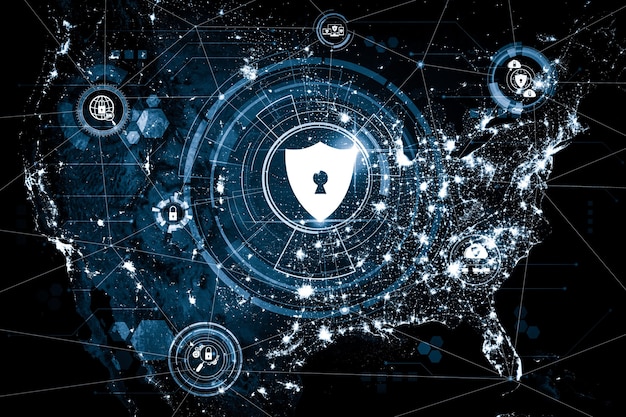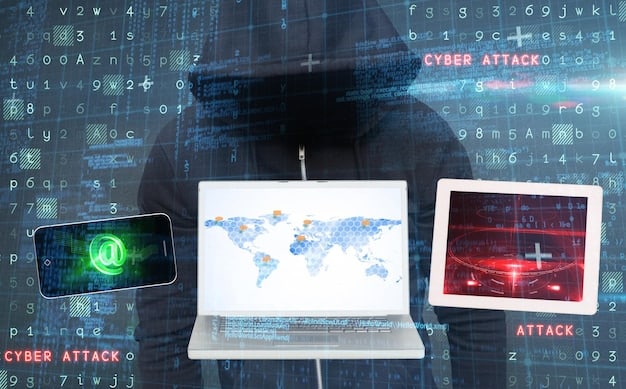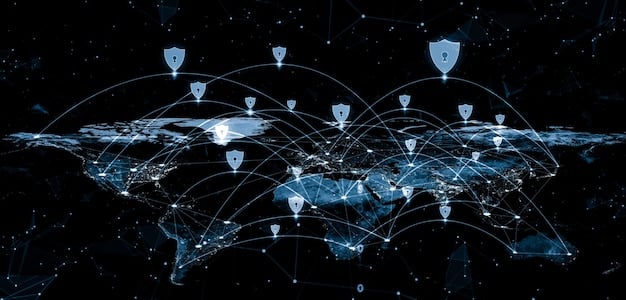Understanding the US Approach to Cybersecurity Threats

Understanding the US Approach to Cybersecurity Threats from Foreign Actors involves a multi-layered strategy encompassing legislative measures, collaboration with international partners, and investment in technological innovation to defend against increasingly sophisticated cyberattacks.
In an era defined by digital interconnectedness, the United States faces an unrelenting barrage of cybersecurity threats emanating from foreign actors. Understanding the US Approach to Cybersecurity Threats from Foreign Actors requires a comprehensive look at the strategies, policies, and collaborations designed to safeguard national interests, critical infrastructure, and the digital landscape itself.
The Landscape of Cybersecurity Threats
The cybersecurity landscape is constantly evolving, with state-sponsored actors, criminal organizations, and individual hackers all posing unique challenges to the United States. These threats range from espionage and intellectual property theft to disruptive attacks on critical infrastructure and disinformation campaigns aimed at undermining public trust.
Key Sources of Cyber Threats
Several countries and groups are consistently identified as primary sources of cyber threats against the US. These actors often possess advanced technical capabilities and operate with varying degrees of state support, making them particularly dangerous adversaries.
Types of Cyberattacks Employed
Cyberattacks can take many forms, each designed to achieve specific objectives. Understanding these different types of attacks is crucial for developing effective defenses and mitigating potential damage.
- Malware and Ransomware: Malicious software designed to disrupt systems, steal data, or extort money from victims.
- Phishing and Social Engineering: Tactics used to trick individuals into divulging sensitive information or granting unauthorized access to systems.
- Distributed Denial-of-Service (DDoS) Attacks: Overwhelming target systems with traffic to render them unavailable to legitimate users.
- Espionage and Data Breaches: Stealthy operations aimed at stealing sensitive information for political or economic gain.

The US approach to cybersecurity threats must be adaptable and comprehensive, capable of addressing a wide range of attack vectors and threat actors. Constant vigilance and investment in cutting-edge technologies are essential for staying ahead of the evolving threat landscape.
Legislative and Regulatory Framework
The US government has established a complex legislative and regulatory framework to address cybersecurity threats. These laws and regulations aim to protect critical infrastructure, promote information sharing, and deter malicious cyber activity.
Key Cybersecurity Laws and Regulations
Several key pieces of legislation form the foundation of the US cybersecurity framework. These laws define the roles and responsibilities of government agencies, establish reporting requirements for cyber incidents, and provide legal authority for defensive and offensive cyber operations.
The Role of Government Agencies
Multiple government agencies play crucial roles in protecting the US from cyber threats. These agencies are responsible for intelligence gathering, threat analysis, incident response, and law enforcement related to cybercrime.
- Cybersecurity and Infrastructure Security Agency (CISA): Leading the national effort to protect critical infrastructure from cyber and physical threats.
- National Security Agency (NSA): Gathering foreign intelligence and protecting US national security systems.
- Federal Bureau of Investigation (FBI): Investigating cybercrimes and pursuing cybercriminals.
- Department of Defense (DoD): Conducting military cyber operations and defending US military networks.
The legislative and regulatory framework provides the necessary legal and organizational structure for the US to effectively address cybersecurity threats. However, ongoing updates and improvements are needed to keep pace with the rapidly evolving threat landscape.
International Cooperation and Alliances
Cybersecurity is a global challenge that requires international cooperation and collaboration. The US works with allies and partners around the world to share information, coordinate defenses, and deter malicious cyber activity.
Key International Partnerships
The US has established strategic cybersecurity partnerships with several countries and organizations. These partnerships facilitate information sharing, joint training exercises, and coordinated responses to cyber incidents.
Challenges and Opportunities in International Cyber Cooperation
Despite the importance of international cooperation, several challenges can hinder effective collaboration. These challenges include differing legal frameworks, conflicting national interests, and concerns about data privacy and sovereignty.
Overcoming these challenges requires building trust, establishing clear protocols for information sharing, and developing common standards for cybersecurity practices. By strengthening international cooperation, the US can enhance its ability to detect, prevent, and respond to cyber threats.

Technological Innovation and Research
Technological innovation is essential for staying ahead of cyber adversaries. The US invests heavily in research and development to develop new cybersecurity technologies and techniques.
Areas of Focus in Cybersecurity Research
Cybersecurity research focuses on several key areas, including: * Artificial Intelligence (AI) and Machine Learning (ML): Using AI and ML to automate threat detection, analysis, and response. * Blockchain Technology: Exploring the use of blockchain for secure data storage and transmission. * Quantum Computing: Developing quantum-resistant encryption algorithms to protect against future quantum computer-based attacks. * Threat Intelligence Sharing: Creating platforms for sharing threat intelligence data among government agencies and private sector organizations.
Public-Private Partnerships in Cybersecurity
Collaboration between the public and private sectors is crucial for fostering cybersecurity innovation. The government works with private sector companies, universities, and research institutions to develop and deploy new cybersecurity technologies.
- Information Sharing and Analysis Centers (ISACs): Industry-led organizations that share threat information and best practices among their members.
- Cybersecurity Research and Development Centers: Government-funded research centers that conduct cutting-edge cybersecurity research.
- Venture Capital and Startup Funding: Investing in cybersecurity startups to bring innovative solutions to market.
By fostering technological innovation and collaboration, the US can maintain its competitive advantage in the cybersecurity domain and effectively address emerging threats.
Incident Response and Recovery
Despite the best prevention efforts, cyber incidents inevitably occur. The US has developed robust incident response and recovery capabilities to minimize the damage from cyberattacks and restore affected systems.
The National Cyber Incident Response Plan
The National Cyber Incident Response Plan (NCIRP) outlines the roles and responsibilities of government agencies and private sector organizations in responding to significant cyber incidents. The NCIRP establishes a framework for coordinating incident response activities and ensuring that resources are effectively deployed.
Best Practices for Incident Response
Effective incident response requires a coordinated and well-rehearsed approach. Organizations should develop incident response plans, conduct regular training exercises, and establish clear communication channels.
Additionally, incident response teams should be equipped with the latest tools and technologies for detecting, analyzing, and containing cyberattacks. Rapid detection, containment, and eradication are essential for minimizing the impact of cyber incidents.
Future Challenges and Priorities
The cybersecurity landscape is constantly evolving, presenting ongoing challenges and requiring continuous adaptation. The US must address several key challenges and prioritize its efforts to maintain a strong cybersecurity posture.
Emerging Technologies and Threats
Emerging technologies such as AI, 5G, and the Internet of Things (IoT) are creating new opportunities for cyberattacks. The US must proactively address the security risks associated with these technologies and develop appropriate safeguards.
Addressing the Cybersecurity Skills Gap
The cybersecurity industry faces a critical shortage of skilled professionals. The US must invest in education and training programs to develop a pipeline of qualified cybersecurity experts.
- Cybersecurity Education Programs: Supporting cybersecurity education programs at universities, colleges, and vocational schools.
- Cybersecurity Training Initiatives: Providing training and certification opportunities for cybersecurity professionals.
- Recruitment and Retention Strategies: Implementing strategies to attract and retain top cybersecurity talent in government and private sector organizations.
By addressing these challenges and prioritizing its efforts, the US can strengthen its cybersecurity defenses and protect against future threats. Constant vigilance, adaptation, and collaboration are essential for maintaining a secure and resilient digital environment.
| Key Point | Brief Description |
|---|---|
| 🛡️ Legislative Framework | Laws and regulations protecting critical infrastructure. |
| 🤝 International Cooperation | Partnerships for sharing threat intelligence and coordinating defenses. |
| 🔬 Technological Innovation | Investing in AI, blockchain, and quantum-resistant technologies. |
| 🚨 Incident Response | Plans and protocols for minimizing damage from cyberattacks. |
Frequently Asked Questions
▼
The US faces a range of cyber threats including malware, ransomware, phishing, DDoS attacks, and espionage, often targeting critical infrastructure and sensitive data.
▼
Key agencies include CISA, NSA, FBI, and DoD, each playing a role in protecting critical infrastructure, gathering intelligence, investigating cybercrimes, and conducting military cyber operations.
▼
The US collaborates with allies and partners to share information, coordinate defenses, and deter cyber activity, despite challenges like differing legal frameworks.
▼
Technology is central, with investments in AI, blockchain, and quantum-resistant encryption to automate threat detection and secure data, fostering innovation.
▼
Future challenges include securing emerging technologies like AI and 5G, and addressing the shortage of skilled cybersecurity professionals to maintain a strong security posture.
Conclusion
In conclusion, **understanding the US approach to cybersecurity threats from foreign actors** requires appreciating the comprehensive and multifaceted strategy employed. This includes legislative measures, inter-agency collaboration, international partnerships, technology innovation, and continuous adaptation to emerging threats. By prioritizing cybersecurity, the US aims to protect its national interests, critical infrastructure, and the digital landscape for years to come.





